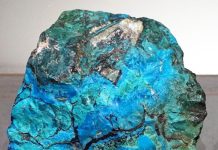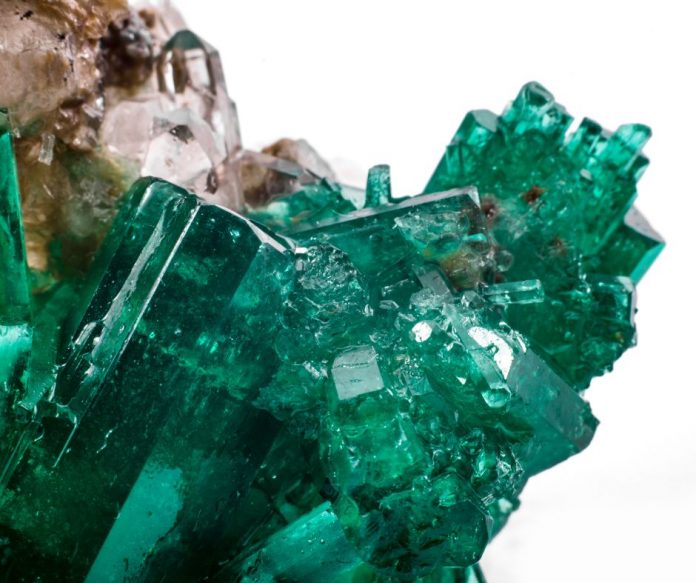
Emeralds are the green variety of the beryl group (Be3Al2Si6O18) of minerals that also includes aquamarine, goshenite, heliodor and red beryl. Best known as the birthstone of May, the green of emeralds also symbolizes royalty.
Exploring Emerald Colors

Emeralds can actually be a variety of hues from bluish-green to green and yellow-ish green. There are also green beryls that are not “true” emeralds.
Chromium and vanadium play the biggest role in an emerald’s color, with iron playing a role occasionally. Emeralds need ingredients from both felsic and mafic rocks to get their color, preferably close in proximity, quite a rare condition in the field.
The quantities and proportions of chromium, vanadium, and iron dictate the specific hue, and thus richness, of an emerald. Green beryl has a pale appearance because iron (both in Fe+2 and Fe+3 forms) is, by far and away, the dominant colorant.
Given that iron is far more abundant in the crust than chromium and vanadium, green beryl is far easier to find. The world-famous Colombian emeralds owe their specific tinge to a total lack of iron while being chromium-dominant, whereas Zambian emeralds (arguably Colombia’s chief rival on emerald quality) is also chromium dominant but display a blue undertone because of trace amounts of iron.
Emerald Inclusions
 With the richness of color being the primary driver of these gems on the world market, the second-place value factor is the degree of inclusions emeralds contain. In the gem market, inclusions are acceptable (unlike how diamonds in the jewelry industry are treated).
With the richness of color being the primary driver of these gems on the world market, the second-place value factor is the degree of inclusions emeralds contain. In the gem market, inclusions are acceptable (unlike how diamonds in the jewelry industry are treated).
Emeralds are classified as a type III gemstone, meaning inclusions are very common and acceptable. Type I gems are inclusion-free more often than not, such as topaz and aquamarine, and type II gems are usually included such as rubies and sapphires.
The unique set of inclusions an emerald gem has is often referred to as its jardin. This is Spanish for “garden” since the term is most often used in Colombian emeralds. Such inclusions are typically elongate and rod-like, resembling tree branches and roots, hence the moniker.
If an inclusion-free emerald is spotted on the market, you are probably dealing with a fake.
Aquamarine vs. Emerald

Some ask how aquamarine and emerald can be on opposite ends of the inclusion spectrum if they are both beryl? The answer lies in the environment where the gems form.
Emeralds are found in sedimentary shale-limestone sequences and boundary zones between pegmatites and high-grade metamorphic rocks such as schists.
Aquamarines are generally confined to just pegmatites. The shale-limestone sequences usually involve a brine solution where a variety of dissolved elements and inclusions persist, and the boundary zones involve the exchange of multiple ingredients from each source (so it gets quite crowded).
Individual pegmatite melts are often supercritical fluids, meaning that distinct liquid and vapor phases no longer exist. These fluids are generated at more than around 375°C and 240 atmospheres of pressure, for water, and possess enhanced solubility of a pure liquid yet the permeability of pure gas. So, when some pegmatites cool to form gems (like type I aquamarine), there is high selectivity of what gets included in the developing crystal structure (hence giving a higher purity).
Colombian Emeralds
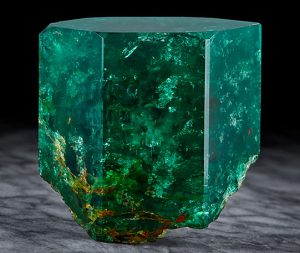
So far, the Colombian deposits are the only well-known examples of the gems forming in the shale-limestone sedimentary environment. This area is divided into western and eastern belts separated by 110 kilometers, where the acclaimed Muzo and Chivor mines reside, respectively.
The gems were worked there by indigenous tribes in the 4th century, with Conquistadors arriving in the early 16th century undertaking more extensive mining. It did not take long for them to realize that their finds would be more attractive than Egyptian emeralds back in Europe (their closest source).
The regional geology is composed of lower Cretaceous-age organic-rich shale and limestone beds that have been intensely folded and intruded by reverse faults during an orogenic event that built up the Colombian Andes.
How Colombian Emeralds Formed

With Colombia being such a unique and important locality to the worldwide emerald market, there have been numerous models to explain the gem formation. In general, the geologic recipe boils down to multi-step fluid reactions, rich carbon contents, the presence of evaporite sedimentary rocks and space to grow.
Seated deeper than the noteworthy shale and limestone formations are sequences of evaporitic sedimentary rocks, rock salt (NaCl) and rock gypsum (CaSO4*2H2O).
The term evaporitic comes from the formation of these rocks, via high evaporation rates of briny waters, that leaves behind the minerals when the remaining solution becomes supersaturated with the dissolved elements. Such past environments are typically deserts and lagoons.
Iron Removal
During mountain building, deep-seated hydrothermal fluids are forced upwards along faults, while interacting with the evaporitic rocks along the way. These fluids also contain Be-F complexes derived from basement granitic rocks.
As they arrive closer to the surface, where the shale-limestone sequences are, the interaction with the carbon in the organic-rich shale reduces the dissolved sulfate (SO4–2) and iron to produce pyrite (FeS2) and elemental sulfur. The transported fluorine also reacts with the calcium in the shale limestone to produce fluorite (CaF2).
The removal of aqueous iron into pyrite is key to the signature grass-green hue in Colombian emeralds.
Rare Columbian Surprises

If the abundant organic matter that dominates the Colombian shales gets entrapped in the growing crystal at the right time, flakes can orient themselves along crystallographic axes intersections. If this is combined with an inconsistent growth rate of the gem, a unique pattern called trapiche emeralds form (the word also refers to a Colombian grinding wheel).
The other Colombian surprise is rarer even yet, in the form of fossil replacements. If fossils are lucky enough to be rapidly buried, their shells can be replaced by minerals such as hematite, pyrite, quartz, and calcite. A few gastropod fossils found in the shale beds have had their shells replaced by emerald.
Zambian Emeralds
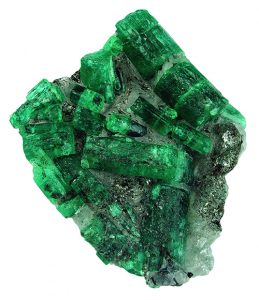
African Zambian deposits occur in a rather rare host of talc-magnetite-actinolite-chlorite schist that was born out of a metamorphosed komatiite (ultramafic lava flows that are too hot to erupt today) around 1.6 billion years ago. The komatiite provided chromium along with iron.
Fast forward to 530 million years ago during the Pan-African orogeny, which saw the development of pegmatite igneous intrusions, that provided the beryllium. The emeralds then grew in a reaction zone along the boundary between the two rock types. Many Zambian gem specimens show a quartz matrix, with some showing solely a mica matrix, but specimens showing both on the matrix are exceptionally rare.
Zambian vs. Columbian Emeralds
Even though Columbian emeralds have more inclusions, they are more valuable than Zambian emeralds. This goes to show that a desirable color, and the historical brand name of Colombian emeralds, takes precedence over having much fewer inclusions but with a slightly less ideal green.
Brazilian Emeralds
Brazil is the source for roughly 10% of world emerald production. The Carnaíba Mine is a part of the largest emerald deposit in the world, in terms of physical size, and was only been discovered in the 1960s with other locales such as Minas Gerais, contributing alongside Carnaíba. Emeralds here tend to be heavily included, and rarely transparent, but still make desirable matrix specimens.
The Brazilian matrix is Precambrian mafic biotite schist that is in proximity to pegmatite intrusions of Proterozoic age. The schist formations themselves are spatially close to chromite mines further to the west, where the chromium chromophore got remobilized during matrix rock intrusion, with the beryllium being delivered from the pegmatite.
The Largest Emeralds
Carnaíba emeralds are nothing to shake a stick at as some major record-breakers have been mined from this area. The first was discovered in the summer of 1974 when a cut specimen weighed in at a whopping 86,136 carats (nearly 38 pounds)!
The largest natural uncut single emerald crystal was found in Colombia (1969) weighing in at 7,205 carats (nearly 3 pounds), called the Emilia Crystal. In more recent times, Carnaíba struck the record books again when a 794-pound, 4.3-foot high, matrix specimen was unearthed in 2017. It took a team of ten, a week, to transport the specimen from 200 meters (656 feet) underground. With an estimated value of $309 million.
The specimen serves as a very close cousin to the infamous Bahia emerald, which was found in 2001 and only 100 meters (328 feet) away. The Bahia was once a subject of a decade-plus long legal battle over its rightful ownership.
Emeralds from Southern China
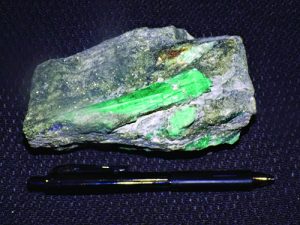
Somewhat like Brazilian emeralds are those produced from the Dayakou Mine in southern China. As with Carnaíba, the Dayakou emeralds are hosted in traditional mica schist and are typically opaque and heavily-included. The geological scene was initially set by Proterozoic metamorphic basement, followed by the emplacement of Silurian-age gneisses and granites, and finally by the intrusion of Cretaceous-age pegmatites supplying heat and beryllium for emerald formation.
Chinese emeralds here are unique for three reasons. First, vanadium, rather than chromium, serves as the dominant chromophore. Second, the gems precipitated out in two different vein orientations; one trending northwest that formed during the Silurian, and the other trending northeast formed during the Cretaceous. Thus, it is plausible that there were two separate gem-forming episodes. Three, a unique association with scheelite (CaWO4), gives some areas of some specimens a nice lemon-lime contrast.
Emeralds Around the World
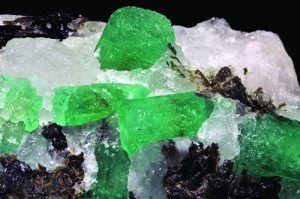
In considering regions a bit further northwest, there are the famous Mingora deposits in northern Pakistan. The Mingora Mine is a part of the nation’s most prolific emerald producer, being the Swat Valley District. Although the emeralds here are derived from a classic convergent plate boundary setting, Mingora emeralds are unique from a big-picture perspective. They are confined to an ophiolite mélange zone (otherwise known as a suture zone).
Ophiolites are slivers of “foreign” lithosphere (crust) that get compressed or stitched, onto the edges of continents, at convergent-ocean plate boundaries where subduction occurs. The “gluing” occurs since the sliver is too thick to be subducted and is often composed of a myriad of rock and sediment types in a chaotic assemblage (the word mélange is derived from the French word to mix – “mesler”). The mélange zone is known as the Indus Suture situated between the Eurasian plate and the Kohistan Island Arc. This specific mélange contains magnesite (MgCO3), chromium-rich and dravite tourmaline, fuchsite – K(Al, Cr)2(AlSi3O10)(OH)2, serpentinite, and talc-dolomite schist.
In parts of the oceanic crust, chromium is typically found in elevated amounts at its base where gabbroic rocks predominate. Hydrothermal activity and element mobilization are generated by the creation of new magma from the subduction process, with gem deposition found sporadically and within numerous thrust faults created by compressional forces in the mélange.
Emeralds in North Carolina
The longstanding epicenter emeralds in the United States is in North Carolina. Colombia and Zambia may have the best gemmy emeralds, and Brazil the largest, but those from the Tarheel State may have the most mystique to them. The deposits are split between two areas; around the town of Hiddenite, and the Crabtree Mine, outside of Little Switzerland 90 miles to the west, and the occurrences are vastly different.
Hiddenite Emeralds
The Hiddenite area has been responsible for the biggest and best finds (so far) in North America. The area can be further divided into the Emerald Hollow Mine, the North American Emerald Mine (the NAEM, a.k.a. the Rist Mine), and the Adams Mine. The general setting places gems in quartz veins alongside siderite, muscovite, calcite, dolomite, albite and rutile all contained within intensely folded biotite gneiss and schistose rocks. A good number of emeralds from this locale bear a distinctive light mint hue. Also found in the area is the titular gem spodumene that also gets its color from trace chromium. The first piece of mystique here is that hiddenite and emerald are rarely found together in the same localized cavity or vein, despite needing the same colorant.
Also, the entire area seems like a mystery in that the source of the beryllium and chromium is still unknown. The lack of scientific answers has not quenched the desire for discovery on all levels. Since operating the NAEM in 1998, the regional king of emeralds, Jamie Hill, has extracted more than 20,000 carats of crystals. The very next year, more than 300 of those carats were cut into legendary beauties such as the 18.8 ct. “Carolina Queen” and the 7.85 ct. “Carolina Prince.” The former was appraised at a million dollars, while the latter set the record as the most paid per carat for a North American cut gem (just shy of $63,700/ct.). The green luck struck again four years later when a record 1,869-carat crystal was successfully extracted and sold to the Houston Museum of Natural Science.
Lastly, in 2006, Hill made history again with the longest crystal extracted, measuring ten inches. Subsequently, it sold for $155,000 during a Beverly Hills auction. One more record was set, in August 2009, at the Adams Mine, where Terry Ledford unearthed a 310-carat specimen that would yield the continent’s largest cut emerald (at nearly 65 carats) called the “Carolina Emperor.” Despite the recent success stories, a systematic way of exploring for the region’s gems is lacking, with veins and pockets randomly coming and going, adding again to the mystique (and drive).
DIY (Dig it Yourself) Emeralds
The only mine in the region where rockhounds can try their luck at finding the green gem is at the Emerald Hollow Mine (www.emeraldhollowmine.com). In general, North Carolina emeralds are typically not known for being as large as their international cousins. Thus, when the next record-keeper is unearthed, it is guaranteed to generate quite the headliner in the rockhounding community.
Crabtree Mine
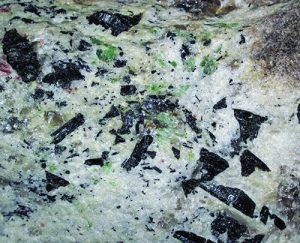
The Crabtree Mine area possesses an entirely different stage for finding gems and the form they come in. Like with most of the discussed locales, the gems grow along a boundary zone between pegmatite and biotite schist. Finding solid three-dimensional crystals is quite tough, whereas most of the eye-popping specimens are displayed as small patches of green en cabochon, alongside feldspar, quartz, black tourmaline, and garnet. The claim is managed by the Mountain Area Gem and Mineral Association (M.A.G.M.A.), and collecting visits can be arranged by visiting wncrocks.com.
With probably the most erratic and random geological distribution, save for probably diamondiferous kimberlite pipes, the precious green gem has captivated humanity for millennia, for better and for worse. It’s only a question of where the next major emerald deposit will be located; it will be striking the geological lottery.
This story about emeralds previously appeared in Rock & Gem magazine. Click here to subscribe. Story by Mark Leatherman.


